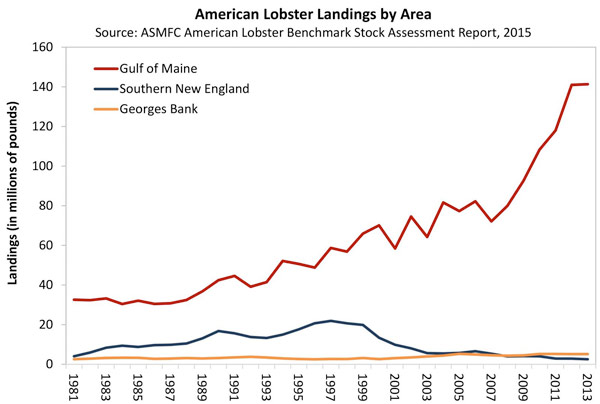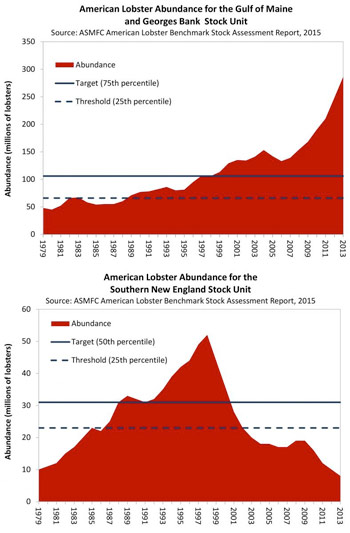Lobster Dilemma
continued from Homepage
Maryland, and Virginia. This fleet is comprised of small vessels in the 22-foot to 42-foot range that make day trips in nearshore waters of less than 12 miles, as well as larger boats of 55 feet to 75 feet that make multi-day trips to the canyons along the continental shelf.

The fishery is managed under Amendment 3 and its 24 addenda. One of the hallmarks of Amendment 3 was the creation of seven lobster conservation management areas (LCMAs) along the coast. The Southern New England fishery is executed in LCMAs 2, 4, 5, and 6, as well as the western portion of LCMA 3.
Industry-led lobster conservation management teams (LCMTs) were asked to come up with proposals for achieving a 5 percent increase in egg production. The ASMFC’s Technical Committee (TC) analyzed the proposals and presented its finding to the ASMFC at its August meeting. According to the TC’s analysis, all but one proposal would fail to achieve the 5 percent increase. The TC’s analysis was based on a 25% reduction in active traps.
Most of the proposals would have instead reduced the trap allocation, which would primarily reduce the number of latent traps, rather than active traps. Some proposals would also have allowed for trap transferability, which would maintain current trap numbers.
Coming from LCMT 5 was the one proposal deemed sufficient. It proposed a 2-millimeter increase in the minimum gauge size, which would achieve a 6 percent increase in egg production, the TC said.
LCMT 6 proposed a decrease in the maximum gauge size, plus nine Sunday closures. The TC said the maximum gauge size change would help protect large lobsters. But, the TC said, Sunday closures would have no effect, since the traps would continue to fish even if they weren’t hauled.
Previous addenda have already established trap reductions. Addendum XVII, implemented in February 2012, established a 10 percent reduction in exploitation for LCMAs 2, 3, 4, 5, and 6 within Southern New England. Addendum XVIII, implemented in August 2012, reduced traps allocated by 50 percent for LCMA 2 and 25 percent for LCMA 3; LCMA 3 lobster fishermen had their trap allocations reduced by 5 percent per year for five years.

Some ASMFC members said the matter was complicated by uncertainty over just how many of the trap hauls were bringing up lobster, versus Jonah crabs and sand crabs. They said the Jonah crab fishery in New England has boomed in recent years, driven by rising dock prices—from 65 cents two years ago to over $1 today for Jonah crabs, and 50 cents to 95 cents for sand crabs. And they noted that some lobster fishermen are using their traps to catch crabs. They noted that hauls of crabs are being counted against lobster hauls, rather than being divided into a separate category, creating an incomplete picture of the trap fishery as a whole.
“The data is skewed,” said ASMFC member Eric Reid, from Rhode Island. “All you have to do is walk down the dock in New Bedford. The amount of traps going into the Jonah fishery is staggering. The data on trap hauls is not correct, because it’s hauls for Jonah crab, and that’s skewing what we have here.” It’s important to get the real data, Reid said, because, ultimately, trap reductions for Southern New England lobster will keep existing lobstermen in business.
But another ASMFC member said the number of traps going into the Jonah crab fishery is not staggering, because they are the same traps that are used for lobster.
One long-time Connecticut fisherman advocated for no further restrictions in Area 6, due to the hardship that area has experienced the stock crashed in the late 1990s.
“At one time, we had 700 license-holders in Long Island Sound,” he said. “Now we have 12 fishermen in Connecticut. We’re just trying to stay in business. Anything you put on will put us out of business….As far as trap reductions, there are trap reductions—we lost all of our fishermen. And a handful are fishing half their gear just trying to survive. Does it make sense to go after 12 guys who are just trying to make a living?”
The ASMFC unanimously approved Area 5’s proposal, deemed sufficient by the TC to achieve a 5 percent increase in egg production. But there was considerable debate about whether it was worthwhile to pursue the proposals submitted by the other areas. ASMFC member Emerson Hasbrouck, from New York, said the proposals showed a commitment to improving egg production, and added that sending the proposals back to the areas for further work would only delay implementation. With regard to Area 6, he agreed it wasn’t worthwhile to impose further restrictions there.
“Landings in Area 6 have already been reduced by 97 percent,” Hasbrouck said. “The number of active permits have been reduced by 90 percent. The active traps fished in Area 6 have been reduced by over 90 percent.” In addition, he said, a clean-up of Long Island Sound removed thousands of derelict pots from the seafloor.
“No one thinks we have a chance to rebuild the lobster population in Area 6,” he continued. “So I don’t see where requiring fishermen in Area 6 to do more will have any more in positive results.”
Another members opposed the insufficient area proposals. “I think we’re going down a bad road when we vote against the technical committee’s recommendation,” he said. “There’s no doubt in my mind that this is just a feel-good addendum. We’re not going to rebuild the Long Island Sound stock.”
ASMFC member Ritchie White, from New Hampshire, said the Southern New England lobster stock is going the way of the northern shrimp stock. “We have to admit we’re not going to rebuild it,” White said. “We have to change our management scheme, because of climate change, and set a much lower standard that would allow some harvest to take place. What we’re doing now is a joke. We’re pretending to rebuild, but we’re not. So let’s change how we manage it and be realistic.”
White advocated for sending the insufficient proposals back to the LCMTs for revision.
“We voted to have a 5 percent increase in egg production, we send it to the LCMTs, and we’re expecting proposals back that meet 5 percent,” White said. “We get proposals back and it’s not 5 percent. So now it’s an argument about why we should accept them, even though it’s not the 5 percent that we passed previously. How can we argue for a proposal that doesn’t accomplish what we said we needed to accomplish?”
“There’s widespread recognition by this board that rebuilding to the lofty levels that we had in the past is not possible,” said another ASMFC member. “Five percent is pretty meager, and it’s within the statistical uncertainty of future stock assessments.” Still, he said, he didn’t support the idea of sending the proposals back to the LCMAs for further work. Instead, he said, he supported waiting for an updated stock assessment to see how well current restrictions are working.
ASMFC member Craig Miner, from Connecticut, said the current proposals were “better than nothing. I don’t think anything that we’d come up with would have any less or more of an impact. Most of the fishermen are out of the water because the lobsters aren’t there. So the reductions are already occurring, because the stock’s not there. We can put in place an artificial parameter, but it won’t have any greater impact on stock rebuilding than keeping the few people we have out there, out there. If we start seeing landing numbers spike, that would be time to revisit this. But I don’t see a spike.”
One ASMFC member said the commission needs to think differently about lobster management in Southern New England. Rebuilding the stock would require a near-complete elimination of fishing, which remains the top cause of mortality, he said.
“So we know there are things we can do,” he said, advocating for sending the proposals back to the LCMAs for revision.
ASFMC member Tom Fote, from New Jersey, said a reduction of traps would not affect that state’s fishery too much, since there are only about 15 active permits there today—a third of the number in the 1990s.
“The industry has reduced itself,” Fote said. “It was a huge problem for those fishermen, but not to the overall economy of New Jersey.” But, he continued, “When I look at our northern brethren and see that warm water moving up and see black sea bass moving in and poor recruitment the last four or five years, I’d be very nervous up in Maine and New Hampshire. So we need to think about how we do a gradual come-down if those same things happen in New England. We’re not talking about 30 permits. We’re talking 4,000 to 5,000 in Maine. That will be a huge economic impact that we haven’t seen in any fishery since groundfish. So we need to think about how to deal with that situation” with respect to the effects of climate change.
In the end, the ASFMC decided not to move forward with Addendum XXV, and to instead establish a workgroup to discuss ways to manage Southern New England lobster.
In further action, the ASMFC approved the initiation of Draft Addendum
XXVII, which seeks to increase the resiliency of the Gulf of Maine/Georges Bank stock by considering the standardization of management measures, including gauge size and v-notch definitions, across the Lobster Conservation Management Areas. As a proactive management action, it’s intended to respond to signs of reduced settlement, according to an ASMFC press release. In 2016, over 158 million pounds were landed coastwide, totaling $666 million in ex-vessel value. The vast majority of harvest occurs within the Gulf of Maine/Georges Bank area, with over 130 million pounds landed in Maine alone. “Since 2012, settlement surveys for the Gulf of Maine/Georges Bank stock have indicated a consistent decreasing trend in young-of-year lobster,” the release said. “This decrease could foreshadow a decline in recruitment and landings.”
